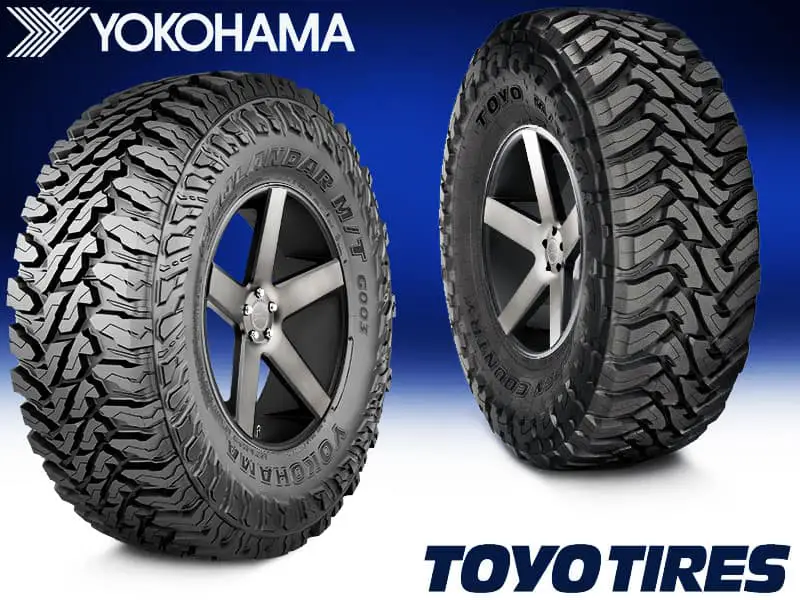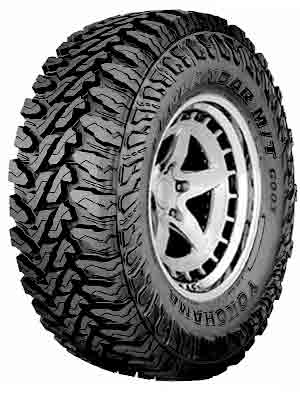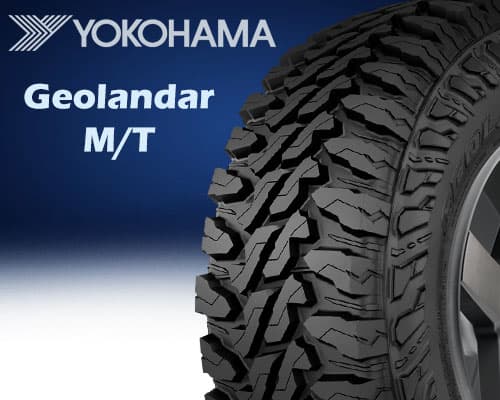Yokohama Geolandar M/T VS Toyo Open Country M/T: Both are Mud-Terrain tires, featuring higher void ratio and aggressive tread designs, so they are brilliant in off-road performance. However, the grooves of Geolandar are comparatively wider, so it gives better off-road performance compared to Toyo since it possesses narrower grooves.
To compare these tires based on their design and performance in different conditions keep reading.

Examine the treads on these tires closely. They hold the key to knowing which to choose. In fact if you visit my "tread design" page, picking the right tire would never bother you.
Table of Contents
Comparing both Mud Terrain Tires:
Yokohama Geolandar M/T

Toyo M/T


Vs

Geolandar features an aggressive innovative tread pattern with a higher void ratio, resulting in a minimum contact patch with the ground. This reduces their on-road dry traction to some extent but wide grooves and deep sipes make this tire outstanding in wet traction. Wide grooves give maximum traction in mud and snow but this tire suffers on icy roads due to its minimum contact patch and lower grip. Bold stone ejectors are also installed to remove stones that are stuck into the tire tread. Moreover, shoulder lugs and aggressive armor prevents damage against sharp-edged rocks. The tread of Geolandar is covered by polyester piles, steel piles, and nylon cover ply to increase its tread life. Its tread compound also contains a good amount of Silica which provides exceptional grip and improves off-road traction. The computerized tread pattern of this tire reduces noise to some extent but it is noisier as compared to its competitor due to its wider grooves.
Toyo also features an aggressive tread pattern with hooked-shaped blocks specialized to give a terrific off-road performance but the grooves of this tire are comparatively narrower, so it is not as efficient as Geolandar for off-roading. However, fewer narrow grooves make it a better choice on paved paths. In wet traction, the narrow grooves and deep sipes allow it to wipe away water but not as efficiently as Geolandar. The wide grooves and open shoulder blocks promote the removal of mud and snow but not as effectively as Geolandar due to its comparatively narrower grooves. On the ice, the higher contact patch of this tire allows it to perform far better than its counterpart. The scalloped shoulder blocks and bold stone ejectors hinder the rocks/stones to get stuck into the tire tread but less wide grooves reduce its grip on rocks, putting it second to its opponent. Furthermore, the specific arrangement of tread blocks aids in noise reduction but narrower grooves are less efficient in absorbing shocks thus reducing its off-road comfort.
On-Road Traction Comparison
Geolandar offers a higher void ratio, therefore, it features wide grooves. Wide grooves result in lowering the contact patch and tire grip on-road dry traction, so it is not a good choice on-road. However, the same grooves are proved effective in wet traction as they are highly functional in wiping away water. Full-depth sipes also help in the evacuation of water, providing excellent grip in wet conditions. As Geolandar has comparatively wider grooves than that of its competitor, so it performs better in wet traction.
Toyo also has a higher void ratio and wide grooves to some extent which reduced the tire grip on dry paved paths. But the void ratio is comparatively lower and grooves are less wider than that of its counterpart, so it grants better traction on dry roads. However, this tire also offers deep sipes but the grooves are narrower so this tire lacks in wiping water and does not perform as efficiently as Geolandar in wet conditions.
Off-Road Traction Comparison
Mud Terrain
The wide grooves of Geolandar offer several biting edges which are functional in biting the mud and throwing it backward, aiding the forward movement of the tire in mud traction. Mud ejectors also help to keep the grooves clear. Moreover, the shoulders are wide enough to allow the mud to pass easily through the shoulder grooves, increasing the off-road capabilities of the tire.
Toyo features comparatively lesser wider grooves which reduce its traction in mud. However, the grooves are capable enough to grab the mud and throw it backward, but this process of grabbing and throwing mud is not as efficient as it is in Geolandar. The open shoulder grooves in this tire are also narrower as compared to its counterpart so they do not allow easy passing of mud through them.
Snow Terrain
Geolandar possesses wider grooves which effectively bites the soft snow and throws it backward, allowing the tire to roll smoothly. The grooves are wider as compared to its competitor so it evacuates soft snow more efficiently. However, on ice, the wide grooves fail to give enough traction as they reduce the contact patch and lower the tire grip, making the tire more slippery.
The grooves of Toyo are, however, capable enough to bite soft snow and throw it back but they are comparatively narrower so resulting in reduced-traction on soft snow. On the ice, the narrower grooves of this tire are proved much effective to grant it with a good grip. So, Toyo is a better option on icy roads.
Rock Terrain
In Geolandar, the bold stone ejectors hinder small stones/pebbles from getting stuck into the tire tread. Also, the wide grooves allow a good grip of this tire over the rocks. An aggressive armor over the sidewall and precisely arranged tread blocks make this tire rigid. The resulting strong built of the tire protects it from the damage offered by the sharp-edged rocks.
In Toyo, the stone ejectors are bold enough to prevent the stone/pebbles from getting stuck into the tread. The decent grooves of this tire also play a role in providing grip over the rocks. It also offers scalloped shoulder blocks which protect it from chips and cuts. However, this tire is unable to beat Geolandar on rocks as they have comparatively lesser wide grooves and smaller stone ejectors.
Which Tire is More Comfortable?
Geolandar is not a comfortable tire for on-road as it offers wider grooves which lower its contact patch and grip over the road. Also, the wide grooves trap more air into them, and when the tire rotates the air particles rush out, producing loud noise. Whereas, this tire gives excellent off-road comfort as the wide grooves act as shock absorbers which functions in damping the effect of jerks.
Toyo, however, is not a comfortable tire on-road but its comparatively narrower grooves make it a better option. The narrower grooves trap fewer air particles inside, resulting in lesser noise production. Although, this tire is also capable to survive the effect of jerks during off-roading, but the narrower grooves reduce the comfort of the tire as they are not much efficient in absorbing shocks.
Treadwear and Durability
In Geolandar the lower contact patch of the tire lowers its rolling resistance because only a limited part of the tire comes in contact with the road. In this way the treadwear is reduced, increasing the durability of the tire. This tire contains a high-density rubber compound that uses a triple polymer combination which increases the life of the tire. Moreover, it offers a rim protector, a hexagonal bead, two steel belts, and a total nylon cap to give the best protection against damage. The comprehensive tread design of Geolandar grants it 8% additional tread life.
Toyo tire also offers a high void ratio and allows minimal contact patch, lowering the rolling resistance of the tire. In this way, the durability of the tire is increased. Tough 3-ply polyester construction gives excellent handling and increases tire durability. Scalloped shoulder tread and toughest sidewalls protect the tire against accidental damage, granting it a strong built. However, Toyo has comparatively lesser wide grooves which increase the treadwear, making this tire a bit less durable.
Difference in Price
Both tires are mud terrain, featuring wide grooves and giving an excellent off-road performance. However, Toyo (M/T) is a bit more expensive than Geolandar (M/T). Both tires are almost equally efficient n their performance but slightly vary from each other in having some additional features.
Quick Summary
- Both are mud-terrain (M/T) tires.
- In the case of on-road dry traction, Toyo performs better due to its comparatively lesser wide grooves.
- In the case of on-road wet traction, Geolandar dominates due to its comparatively wider grooves.
- In mud, Geolandar shows the way to Toyo because its grooves are comparatively wider.
- On soft snow, Geolandar is a better option due to its wider grooves.
- On the ice, Toyo performs better because its grooves are less wide.
- On rocks, Geolandar shows superiority because it has comparatively bolder stone ejectors and wider grooves.
- Geolandar is more durable due to its stronger
- Toyo is slightly more expensive.



